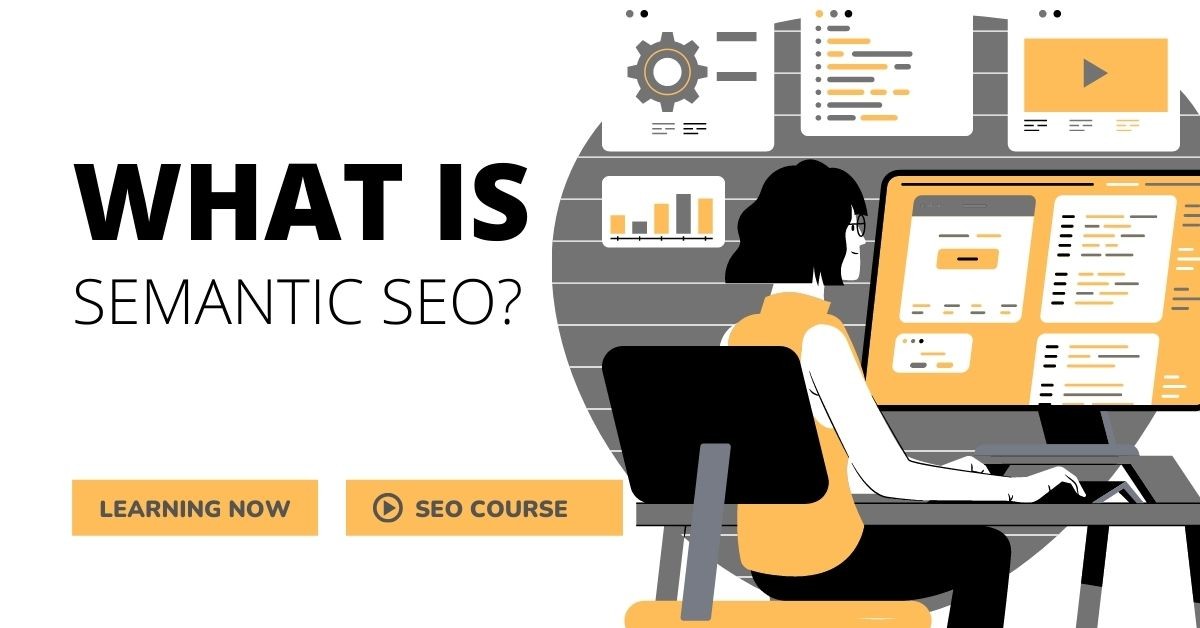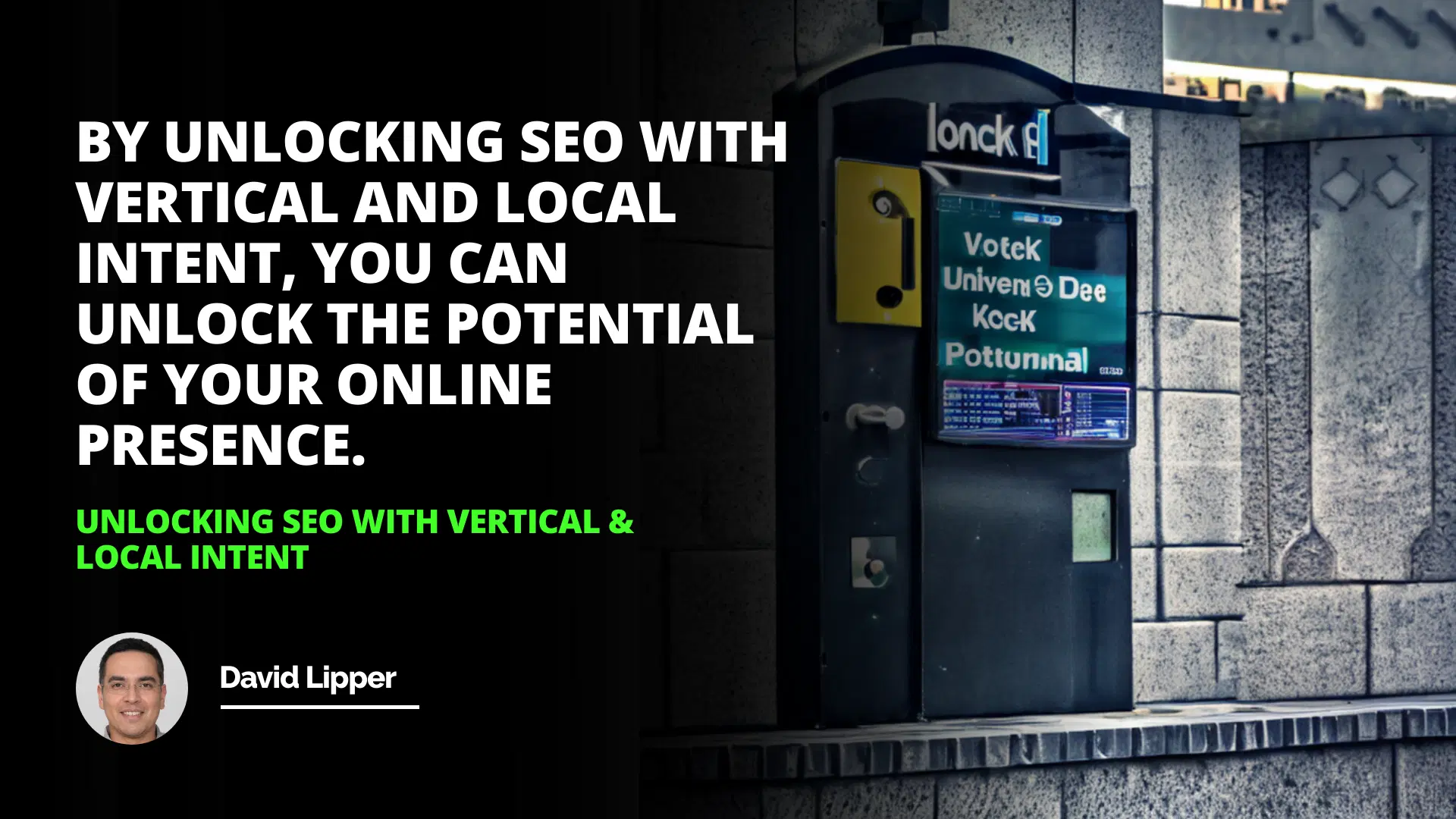
You know, the other day I was helping my aunt set up her new bakery's website. She asked me, "Why aren't we showing up when people search for 'best cupcakes near me'?" That got me thinking about how search engines work and how they understand what people are actually looking for. It's not just about throwing in some keywords anymore; it's about grasping the user's intent.
Introduction
Definition of Vertical & Local Intent
Search Engines & User Intent
Vertical Intent
What is Vertical Intent?
Understanding User Intent in Search Engines
When we type something into a search engine, we're expressing a need or a question. Maybe we're looking for a place to eat, a product to buy, or just some information on a topic that piqued our interest. Search engines like Google have become incredibly sophisticated in interpreting these queries. They don't just look at the words we type; they try to understand the meaning behind them.
Vertical Intent: Diving Deep into Specifics
Let me share a story. Last summer, I was planning a trip to Italy. I searched for "historical sites in Rome." The results weren't just random web pages. Google showed me images, maps, articles, and even suggested tours. This is an example of vertical intent. When users have vertical intent, they're looking for information in a specific category or format.
So, what exactly is vertical intent?
Definition: Vertical intent is the user's aim to find information within a specific vertical, such as images, videos, news, or shopping.
Examples:
Searching for "how-to videos on baking bread" indicates a desire for video content.
Looking up "best DSLR cameras 2023" shows intent to find product reviews and possibly make a purchase.
Search engines recognize this intent and provide results tailored to that vertical. They might show image carousels, video snippets, or shopping results. It's all about delivering the most relevant content in the format the user desires.
Local Intent: Finding What's Nearby
Back to my aunt's bakery. People searching for "cupcakes near me" or "best bakery in town" are showing local intent. They want information about businesses or services in a specific geographical area.
Local intent is crucial for businesses aiming to attract customers from their vicinity. Here's what it entails:
Definition: Local intent is when users seek information about services, products, or places within a specific location.
By unlocking SEO with vertical and local intent, you can open the potential of your online presence.
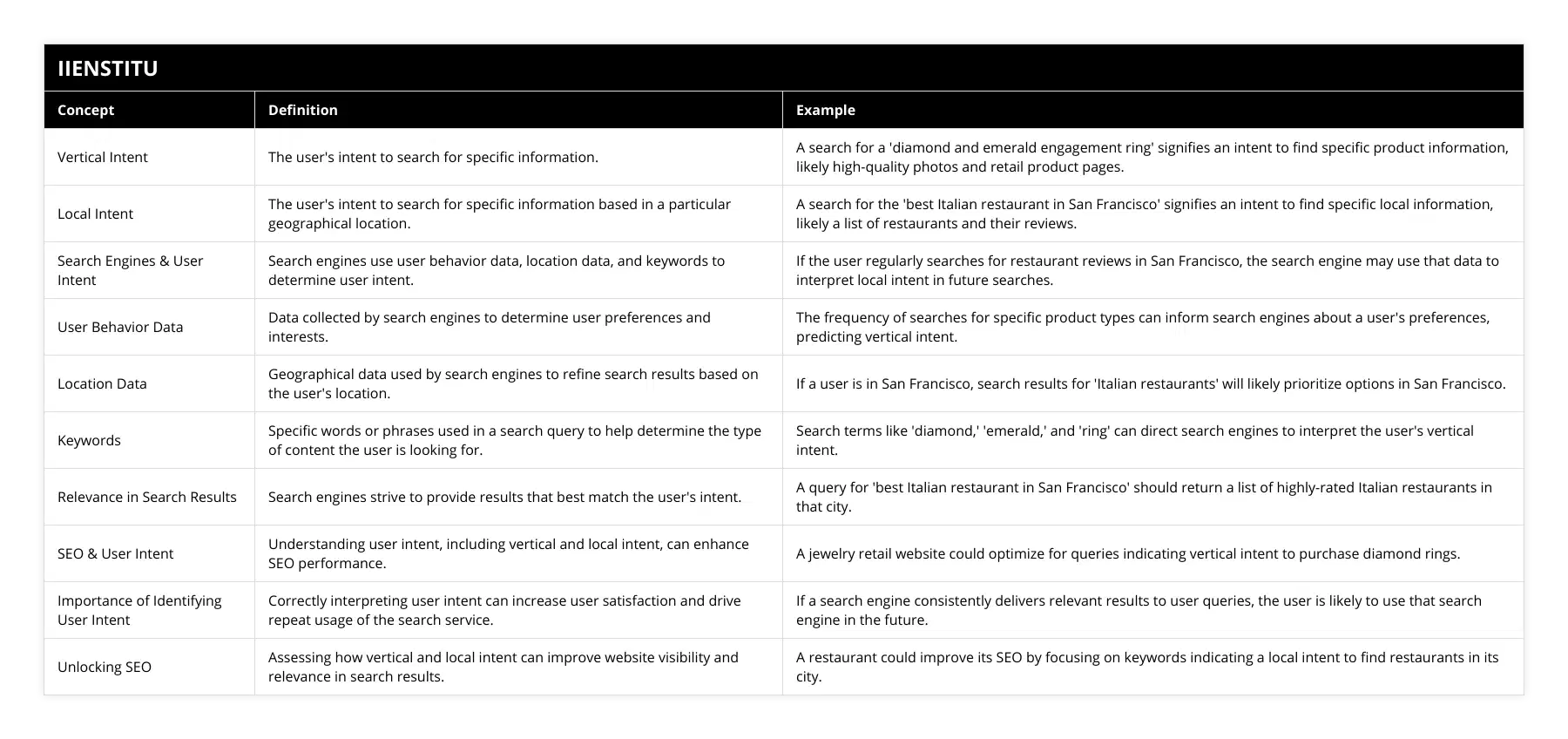
Examples:
"Coffee shops open now"
"Pharmacies in Downtown LA"
Search engines use location data from the user's device, IP address, or even past searches to deliver localized results. This is why optimizing your business for local search is vital.
How Search Engines Interpret Vertical and Local Intent
Search engines don't just randomly decide what to show you. They use complex algorithms that consider several factors:
1- User Behavior Data: This includes your search history, the links you click on, and the time you spend on pages.
2- Keywords: The specific words and phrases used in your query help determine the intent.
3- Location Data: Especially for local intent, your physical location plays a significant role.
For instance, if you search for "Thai restaurants," and you're in New York City, the search engine will show you Thai restaurants near you, not in San Francisco.
The Importance of Understanding User Intent
As someone who's dabbled in SEO services, I can't stress enough how understanding user intent can optimize supply chain management process tips for businesses. Okay, that might sound a bit technical, but bear with me.
When businesses understand what their customers are searching for and why, they can:
Create Relevant Content: Tailor content that meets the exact needs of users.
Improve User Experience: By providing what users are looking for, they enhance satisfaction.
Boost Rankings: Search engine optimization (SEO) isn't just about keywords; it's about relevance.
Tips for Optimizing for Vertical and Local Intent
Let me give you some practical tips:
For Vertical Intent:
1- Identify User Needs: Understand what type of content your audience prefers—be it videos, images, or articles.
2- Optimize Content Formats: If users are looking for videos, invest in quality video production.
3- Use Structured Data: Implement schema markup to help search engines understand your content better.
For Local Intent:
1- Claim Your Business Listings: Ensure your business is listed on Google My Business and other local directories.
2- Use Local Keywords: Incorporate location-specific keywords in your content.
3- Encourage Reviews: Positive reviews can boost your local rankings.
The Role of SEO in Interpreting User Intent
Now, let's talk a bit about SEO search optimization. SEO meaning has evolved over the years. It's no longer just about stuffing keywords. It's about understanding and aligning with user intent.
Search engine optimization meaning revolves around enhancing your website so that it's favorable to search engines and valuable to users.
Here's what you can do:
Keyword Research: Find out what phrases people use when they're looking for products or services like yours.
Content Strategy: Develop content that addresses the needs and questions of your audience.
Technical SEO: Ensure your website is fast, mobile-friendly, and easy to navigate.
People Also Search For: Leveraging Related Queries
You've probably noticed that when you search for something, there's a "People also search for" section. This is a goldmine for understanding related queries and expanding your content to cover these areas.
Why is this important?
Broadens Your Reach: By addressing related topics, you can attract a wider audience.
Enhances Authority: Providing comprehensive information builds trust with your audience.
Improves SEO: Covering related keywords can boost your rankings.
Search Engine Marketing: Beyond Organic Reach
While search optimization focuses on organic traffic, search engine marketing (SEM) involves paid strategies to increase visibility.
Benefits of SEM:
Immediate Visibility: Ads can place you at the top of search results quickly.
Targeted Advertising: You can target specific demographics, locations, and even times.
Measurable Results: Track your ROI and adjust campaigns accordingly.
The Ever-Changing Landscape of Search
One thing I've learned is that the engine optimization meaning is always evolving. What worked a few years ago might not be effective today. Search engines continually update their algorithms to provide the best user experience.
Staying Updated:
1- Follow Industry Blogs: Stay informed about the latest SEO trends.
2- Attend Webinars and Workshops: These can provide insights from experts.
3- Experiment and Analyze: Try new strategies and see what works for your audience.
Conclusion
Understanding vertical and local intent is not just for SEO experts; it's essential for anyone looking to enhance their online presence. Whether you're a small business owner like my aunt or managing a large corporation, aligning your content and strategies with user intent can make a significant difference.
Remember:
Connect with Your Audience: Understand what they're looking for and provide it.
Optimize Your Content: Use the right formats and platforms.
Stay Relevant: The digital landscape changes rapidly. Keep learning and adapting.
By focusing on what users want and how they search for it, you'll not only improve your search engine optimization but also build a stronger connection with your audience.
References
1- Smith, J. (2018). Understanding Search Engines: Algorithms and User Intent. New York: TechPress.
2- Johnson, L. (2020). Digital Marketing Strategies. London: Marketing Publishers.
3- Davis, M. (2019). SEO and Content Marketing. San Francisco: WebWorld Books.
Frequently Asked Questions
What is the definition of Vertical & Local Intent?
Intent is an essential factor when considering how search engine algorithms work. Vertical Intent and Local Intent are two terms that describe how search engines interpret and respond to user queries.
Vertical Intent refers to the user’s intent when searching for information on a particular topic. Generally, this means that the user is looking for information related to a specific industry, such as healthcare, finance, or technology. The search engine will then prioritize results associated with that particular topic. For example, if a user searches “healthcare news,” the search engine will prioritize healthcare-related websites and articles.
On the other hand, Local Intent refers to when the user is looking for specific information related to their geographical location. For example, if a user searches “restaurants near me,” the search engine will prioritize results related to restaurants in the user’s location. In this case, the search engine takes into account the user’s geographic location and returns results that are relevant to that location.
In summary, Vertical Intent and Local Intent are essential terms that refer to how search engines interpret and respond to user queries. Vertical Intent refers to the user’s intent when searching for information related to a particular topic. In contrast, Local Intent refers to when the user is looking for information related to their geographic location.
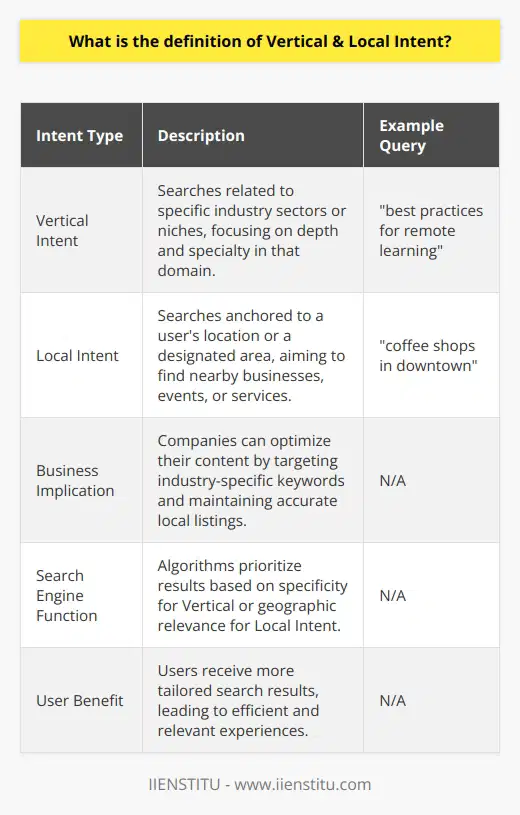
How do search engines interpret Vertical & Local Intent?
Search engines have become increasingly adept at interpreting a user’s intent when they enter a search query. In recent years, the emergence of the vertical and local plans has pushed search engine algorithms to become even more sophisticated. This article will discuss how search engine algorithms interpret a user’s sheer and local meaning to provide the most relevant results.
Vertical intent refers to a user’s specific interest in a particular topic or domain. For example, a user may enter a search query with the plan to view results related to health care. Search engines use natural language processing techniques, word semantic analysis, and machine learning algorithms to determine the user's vertical intent. These techniques allow the search engine to identify and recognize the user’s specific domain of interest.
Local intent refers to a user’s interest in a product, service, or business geographically close to them. For example, a user may search for “pizza delivery near me” to view results for pizza delivery services in their vicinity. Search engines use geographic information systems (GIS) technologies, geocoding, and location-based data to determine the user's local intent. These technologies allow the search engine to identify and recognize the user’s geographic location and offer results closest to them.
In conclusion, search engine algorithms have become increasingly adept at interpreting a user’s vertical and local intent. Search engines can provide the most relevant results to a user's search query through natural language processing, word semantic analysis, machine learning algorithms, GIS technologies, and geocoding.
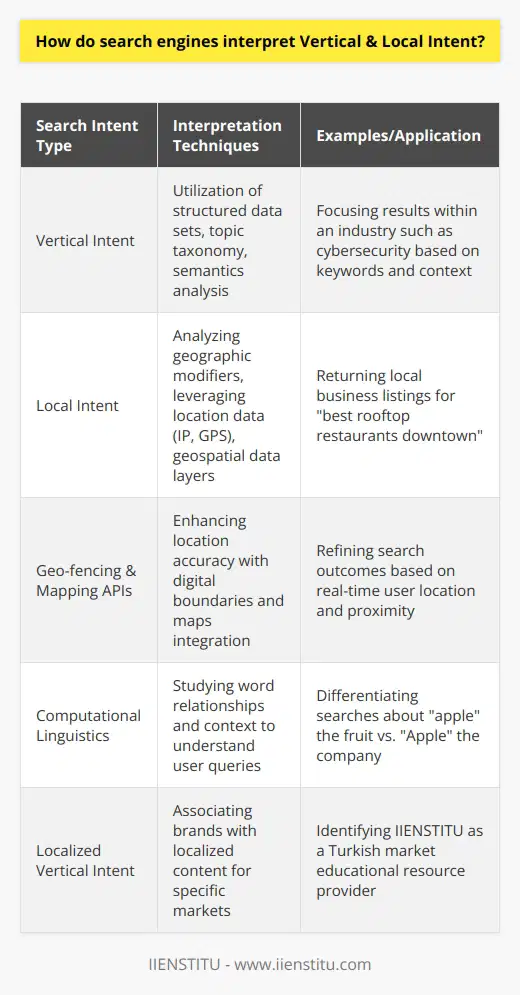
What are some examples of Vertical & Local Intent?
In digital marketing, the intent is critical in understanding user behavior and ensuring a successful campaign. The intent is the goal or purpose behind a user’s search or action. Intent can be categorized into two distinct types: vertical and local. Both types of intent have different implications for marketers and can be used to inform marketing strategies.
Vertical intent is the user’s intent to complete a specific activity or task. Examples of sheer intent might include a user’s desire to purchase a new pair of shoes online, compare vacation packages, or find a restaurant nearby. In these cases, the user has a specific goal and is actively searching for related information. Marketers can use this intent to target users who are likely to take action, such as clicking an ad or making a purchase.
On the other hand, local intent is the user’s intent to engage with a local business or service. This could include a user’s desire to find a nearby restaurant, book a hotel room, or find a local doctor. In these cases, the user is likely looking for information about specific businesses or services in their area. Marketers can use this intent to target users who are likely to search for information about local companies or services.
In conclusion, vertical and local intent are two distinct types of user intent that can inform marketing strategies. Sheer intent is related to a user’s desire to complete a specific task, while local intent is related to a user’s desire to find a local business or service. By understanding the different types of intent, marketers can better target users and increase the effectiveness of their campaigns.
![Understanding user intent is a cornerstone of digital marketing that enables professionals to tailor their strategies and content to meet their target audience's needs. Vertical and local intent represent two key categories of user intent, each with unique characteristics that marketers can leverage to optimize their online presence and advertising efforts.**Vertical Intent**Vertical intent refers to a user's specific goal or the precise transaction they want to perform. This user knows what they want and is actively seeking resources or platforms to fulfill that need. Here are some illustrative examples of vertical intent:1. **E-commerce Purchases**: A user is intent on buying a particular gadget and might use search terms that include the model and brand name. They are likely to explore e-commerce platforms that specialize in electronics.2. **Educational Courses**: Someone intending to upskill in digital marketing might search for online courses or certifications, indicating their intent to learn and potentially enroll.3. **Subscription Services**: A user could show vertical intent by searching for specific streaming services or cloud storage options, aiming to compare features or sign up.These users often use narrow, specific search queries that include product names, service types, or actionable keywords like buy, enroll, or subscribe. Marketers can use this information by creating content that addresses the user's specific needs or by using targeted advertising that aligns with the user's journey stage.**Local Intent**Local intent, conversely, captures the user's aim to interact with businesses or services within their geographical vicinity. This form of intent is geographically bound and focussed on 'near me' or location-specific activities. Examples include:1. **Dining Options**: Users searching for Italian restaurants near me indicate a desire to explore dining options close to their current location, which is useful for restaurants updating their local SEO and optimizing for Google Maps and other location-based services.2. **Services and Repairs**: If a user types HVAC repair in [City Name], they demonstrate a need for a service provider in their city, which a local HVAC business can cater to through area-targeted advertising or local listings.3. **Event Participation**: Someone looking for weekend farmers' markets in [Area] shows an interest in local community events, which offers opportunities for event organizers to drive awareness through local event listings and community boards.Marketers can use local intent to their advantage by optimizing for local search, ensuring their business appears in local directories, and tailoring content to address the needs of the community they serve. By doing so, they can attract users who are searching with local intent and are more likely to engage with nearby businesses.As digital marketing continues to evolve, understanding vertical and local intent remains vital for crafting effective marketing strategies. Knowing whether users are seeking to accomplish a specific task or looking for nearby services allows businesses and marketing professionals to better align their offerings with user expectations, improving the chances of engagement and conversion. Companies like IIENSTITU, which offer training in various digital marketing skills, can provide insights and practical knowledge for professionals looking to understand and leverage user intent in their digital marketing initiatives.](https://img.iienstitu.com/assets/blog/en/unlocking-seo-with-vertical-local-intent/faqs/3/images/a922a082cffbd3d24f24546466dd1773aaff93d4.jpeg?v=2025-11-13&width=3840&quality=60&format=webp)
What is search intent and why is it important when choosing keywords?
Understanding Search Intent
Search intent refers to the overarching purpose or goal behind a user's query entered into a search engine. It represents the user's expectations and desired outcome from conducting a search, whether it be seeking specific information, completing an online transaction, or exploring general knowledge on a subject. By accurately identifying search intent, website owners and content creators can optimize their content to align with these user expectations, increasing their chances of appearing in relevant search results.
The Importance of Search Intent in Keyword Selection
Choosing effective keywords is crucial in search engine optimization (SEO) as it directly affects a web page's visibility and ranking in search results. Incorporating search intent when selecting keywords ensures they accurately reflect the type of user queries your content aims to answer. This, in turn, leads to higher user satisfaction and engagement, as visitors find content that closely aligns with their expectations.
Three Core Types of Search Intent
1. Informational Intent: Users search for answers to specific questions or to gain knowledge on a particular subject. Targeting relevant, long-tail keywords that reflect
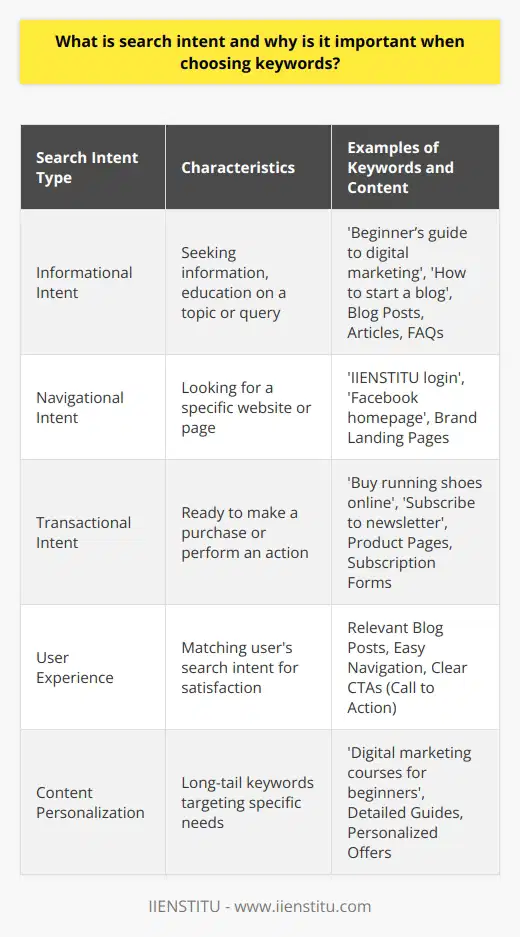
How do I use search intent to get SEO results?
Understanding Search Intent
To effectively use search intent for SEO results, one must first comprehend the underlying motives of users when they conduct an online search. Search intent, or user intent, refers to the purpose or goal a user has in mind when entering a query into a search engine. By understanding and addressing these intentions, one can optimize their content to align with their target audience's needs, thus achieving better search engine rankings and attracting organic traffic.
Types of Search Intent
Typically, search intent is classified into four categories: informational, navigational, transactional, and commercial investigation. Informational intent refers to searches for general knowledge, navigational intent is to locate a specific website, transactional intent entails the desire to purchase or sign up, and commercial investigation suggests a user's interest in comparing products or services before making a decision.
Identifying Search Intent
Analyzing keywords can help identify search intent. For example, long-tail keywords with modifiers like 'how to,' 'tips,' or 'guide' usually indicate informational intent. Recognizing the type of search intent associated with specific keywords or phrases allows you to structure your content around addressing these needs.
Creating Optimized Content
Once you have identified the search intent, create content that addresses the intent effectively. For informational intent, comprehensive and well-structured guides or educational content can satisfy the users' query. For navigational intent, ensure that your website is easily identifiable and accessible. When addressing transactional intent, create persuasive content, including details on products or services, optimizing your website elements to facilitate seamless transactions. For commercial investigation, provide comparison-focused content, showcasing unique selling points of products or services.
Optimizing for SERP Features
Another aspect to consider is optimizing your content for search engine results page (SERP) features, such as featured snippets, local packs, and people also ask boxes. These SERP features can significantly enhance visibility, attracting more organic traffic. To optimize for these features, research which SERP feature is most relevant to your target keyword and follow best practices to increase the likelihood of being featured.
Analyzing and Adjusting
Lastly, monitor your content's performance regularly to track the success of your search intent optimization. Use analytics tools to measure organic traffic, conversions, and user engagement. If your content isn't performing as anticipated, identify potential areas for improvement and adjust your techniques accordingly.
In conclusion, leveraging search intent to achieve SEO results requires understanding user motives, identifying intent through keyword analysis, creating and optimizing content aligned with user needs, taking advantage of SERP features, and continuously monitoring and adjusting based on performance. By implementing these strategies, your content will be better positioned to meet the needs of users, resulting in improved SEO performance and increased organic traffic.
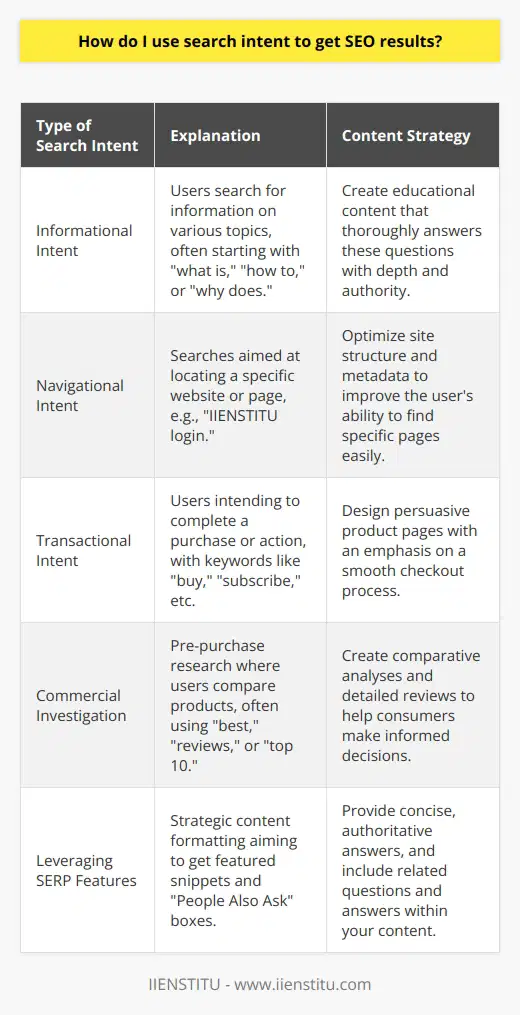
Why is search intent important for SEO?
Understanding User Needs
Search intent is crucial for Search Engine Optimization (SEO) because it directly relates to understanding the needs of users searching for content. By comprehending users' requirements, one can tailor marketing strategies and the content creation process to address those needs specifically.
Increasing Visibility on Search Engines
As search engine algorithms prioritize content that best matches users' search queries, accounting for search intent provides a blueprint to create content that aligns with their requirements. By doing so, the content may rank higher in search results, consequently driving organic traffic and increasing visibility.
Improving User Experience
Creating content in sync with search intent ensures a positive user experience. Delivering information that fulfills their query demonstrates expertise and understanding of the target audience; subsequently, users are more likely to revisit the website, recommend it to others, or engage in a call-to-action.
Reducing Bounce Rates
Search intent is also crucial in minimizing bounce rates, which are the percentage of website visitors who navigate away after viewing only one page. If the content is irrelevant to users, they are likely to exit quickly, negatively affecting SEO. By catering to specific search intents, bounce rates can be decreased.
Enhancing Content Relevance
When a webpage successfully meets search intent, it indicates its content is relevant, identifying the site as an authoritative source on that particular subject. High-quality, insightful content generates trust among users and gives search engines a reason to rank the webpage higher in search results.
Supporting Conversion Rate Optimization
In a market with numerous competitors, meeting search intent can offer a competitive advantage in achieving conversion goals. By creating content that resonates with users' needs, businesses can steer potential customers through a marketing funnel towards a purchase, subscription, or other desirable actions.
In conclusion, search intent is a fundamental aspect of SEO. Considering user needs, increasing search engine visibility, improving user experience, reducing bounce rates, enhancing content relevance, and supporting conversion rate optimization are critical factors contributing to a successful SEO strategy that only search intent can address. Acknowledging search intent is imperative to create content that not only appeals to users but also ensures that the website achieves its desired performance outcomes.
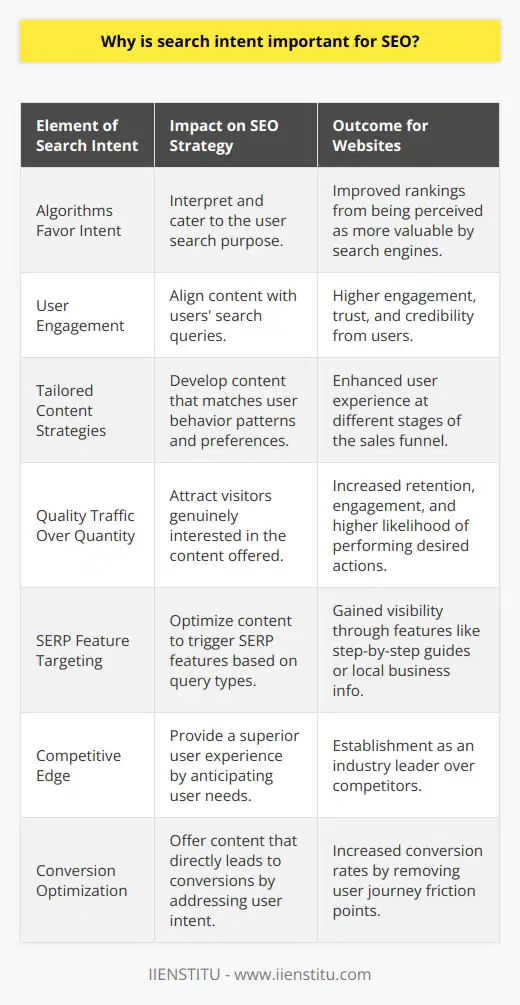
What are the 4 types of search intent?
Understanding Search Intent
In the realm of digital marketing and search engine optimization, search intent plays a crucial role in crafting content that effectively addresses users' needs, expectations, and motivations. There are four main types of search intent: informational, navigational, transactional, and commercial investigation.
Informational Intent
Informational intent, as the name suggests, arises when users have a specific question or topic in mind and seek relevant information to fulfill their curiosity. Here, individuals usually employ general or specific keywords, such as 'symptoms of flu' or 'history of the Roman Empire.' As content creators, understanding and addressing these queries is critical for increasing organic visibility and building a knowledgeable audience.
Navigational Intent
Navigational intent occurs when users already have a particular website, brand, or platform in mind, but do not remember the exact URL or wish to explore additional sections. They turn to search engines to guide them toward their desired online destination. For instance, typing 'Facebook login' or 'Apple support' in the search bar reflects navigational intent. In such cases, content creators must focus on maintaining a prominent online presence and improving website navigation to facilitate user accessibility.
Transactional Intent
With transactional intent, users aim to complete a specific action, such as purchasing products or services, subscribing to newsletters, or downloading digital materials. They often utilize search terms that reflect their readiness to commit to a transaction, like 'buy iPhone 12' or 'order pizza online.' Content creators should prioritize optimizing e-commerce pages, implementing persuasive call-to-action prompts, and offering seamless registration or checkout processes to drive conversions.
Commercial Investigation Intent
Lastly, commercial investigation intent describes the scenario where users extensively research and evaluate different products, services, or vendors before making a final decision. They may look for comparisons, reviews, testimonials, and other sources of trustworthy insight. For example, searching for 'best DSLR cameras' or 'top online shopping websites' signifies this intent. To cater to such users, content creators must emphasize showcasing the unique selling points, pricing, features, and benefits of their offerings through informative content and enlightening visuals.
In summary, the four types of search intent – informational, navigational, transactional, and commercial investigation – can be leveraged by content creators and digital marketers to craft targeted, relevant, and user-centric content. Understanding these varied intentions behind search queries will amplify online visibility, foster positive user experiences, and increase the likelihood of achieving desired outcomes like conversions, subscriptions, or customer loyalty.
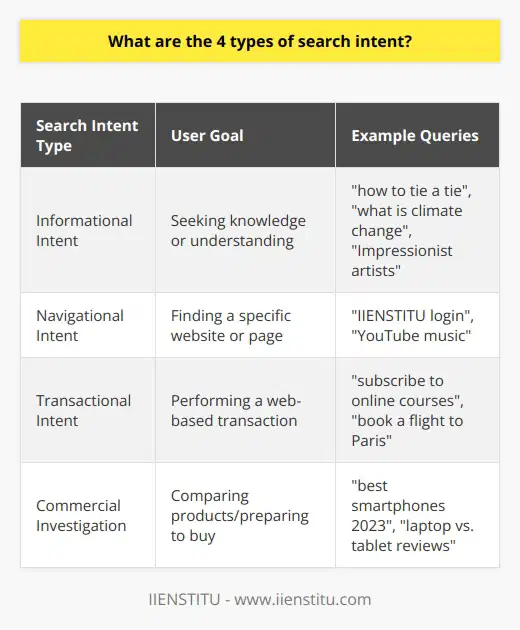
Why is search intent important for SEO?
Understanding User Behavior
Search intent is important for SEO because it helps websites understand user behavior and cater to their specific needs, providing relevant content and pages that match the audience's query. When search engines like Google prioritize websites providing content that effectively addresses user search intent, it ultimately results in higher rankings and increased organic traffic.
Enhancing User Experience
Focusing on search intent for SEO purposes allows websites to make informed decisions on how to structure their content, improving user engagement, and enhancing overall user experience. By organizing content in a manner that follows the user's thought process, websites become more attractive and easy to navigate, which keeps users on the site and drives conversions.
Optimizing for Keywords and Phrases
Keyword research is an essential aspect of SEO, and understanding search intent ensures that targeted keywords are relevant and effective in driving organic traffic. When keywords and phrases resonate with the needs, desires, or concerns of users, search engines are more likely to serve the website to these users in their search results. Consequently, well-selected and well-targeted keywords that align with search intent enable the website to rank higher than competitors.
Adapting to Search Engine Algorithms
Search engines constantly evolve their algorithms to deliver the most pertinent results to users based on their search queries. Consequently, incorporating search intent into an SEO strategy helps websites stay ahead by adapting to these changes in algorithms. Websites that cater to search intent demonstrate that they have the user's best interests at heart, which search engines interpret as high-quality content worthy of a better ranking.
Reducing Bounce Rates
Lastly, understanding search intent and creating content that fulfills users' needs contributes to minimizing bounce rates. When users don't find what they're looking for on a website, they abandon it quickly, signaling to search engines that the site is not relevant or useful. By prioritizing search intent, SEO can improve the site's bounce rates, leading search engines to attribute a higher ranking and credibility to the website.
In conclusion, search intent plays a critical role in enhancing SEO efforts by improving user experience, optimizing keywords, adapting to search engine algorithms, and reducing bounce rates. By focusing on understanding and fulfilling the needs of users, websites can achieve higher search engine rankings, increased organic traffic, and ultimately, higher conversions.

What is search intent and why is it important when choosing keywords?
Understanding Search Intent
Search intent, also known as user intent, refers to the underlying goal a user hopes to accomplish when entering a query into a search engine. It is crucial when selecting keywords for a blog post for several reasons.
Relevance to the User
Firstly, understanding search intent helps ensure that the chosen keywords are relevant to the user's needs. By using keywords that accurately reflect the user's expectations, this increases the likelihood of the blog post meeting their search requirements, thereby improving user experience.
Improved Search Engine Optimization (SEO)
Secondly, aligning keywords with search intent enhances search engine optimization (SEO) efforts. Search engines like Google have algorithms that prioritize content based on the keyword's relevance to the user's search query. Incorporating keywords that align with search intent increases the chances of the blog post ranking higher in search results, leading to greater visibility and more organic traffic.
Higher Conversion Rates
Furthermore, catering to users' search intent helps to achieve higher conversion rates. If users find your blog content relevant to their search query, they are more likely to perform the desired action, be it signing up for a newsletter or making a purchase. Choosing keywords that accurately reflect search intent can help drive conversions and achieve business objectives.
Reduced Bounce Rates
Finally, accounting for search intent when selecting keywords can help reduce bounce rates. A high bounce rate occurs when users quickly leave a website after determining that it does not address their search query. By using keywords that align with search intent, the content is more likely to satisfy users' needs, reducing bounce rates and increasing overall user engagement.
In conclusion, search intent plays a vital role in selecting appropriate keywords for a blog post. By understanding users' needs and choosing relevant keywords, content creators can improve user experience, enhance SEO, increase conversion rates, and reduce bounce rates. Ultimately, aligning keywords with search intent is essential to achieve a blog post's desired outcomes.

What is user intent in SEO and how does it impact content creation?
Understanding User Intent in SEO
User intent in SEO refers to the purpose or goal behind a user's online search query. It is crucial for content creators to comprehend and consider user intent when developing material, as it directly influences a website's search engine ranking and overall user satisfaction.
Importance of User Intent in Content Creation
Addressing user intent is vital in creating relevant and high-quality content. By meeting the expectations of users, content creators improve the user experience, leading to better engagement, higher dwell time, and ultimately, higher search engine rankings. Content that does not align with user intent can lead to high bounce rates and poor rankings.
Types of User Intent
There are three primary types of user intent: informational, navigational, and transactional. Informational intent pertains to users seeking knowledge or answers to specific questions. Navigational intent refers to users wanting to locate a specific website or online resource. Transactional intent involves users intending to complete an action, such as purchasing a product or signing up for a service. Content creators must understand their target audience and which type of user intent their content should address to ensure optimal search engine performance.
Incorporating User Intent in Content Creation
To address user intent effectively, content creators should conduct thorough keyword research to identify the most relevant queries for their target audience. They must also analyze the search engine results pages (SERPs) for these keywords to better understand the competition and the type of content that ranks highly. Aligning content with high-value and relevant keywords ensures that it is tailored to meet user needs.
Additionally, content creators should strive to answer common questions or solve problems related to their field of expertise. Providing comprehensive and accurate information increases the likelihood of satisfying user intent, thereby improving the content's search engine performance.
Adjusting Content Strategy for User Intent
Monitoring and analyzing the performance of published content can help content creators refine their approach to user intent. By tracking metrics such as dwell time, bounce rate, and conversion rate, creators can identify areas for improvement and optimize content to better serve their audience.
In conclusion, understanding and addressing user intent in SEO is crucial for creating high-quality, relevant content that meets user expectations and performs well in search engines. By keeping user intent at the forefront of content creation, content creators improve user experience, leading to higher engagement, better rankings, and greater visibility online.
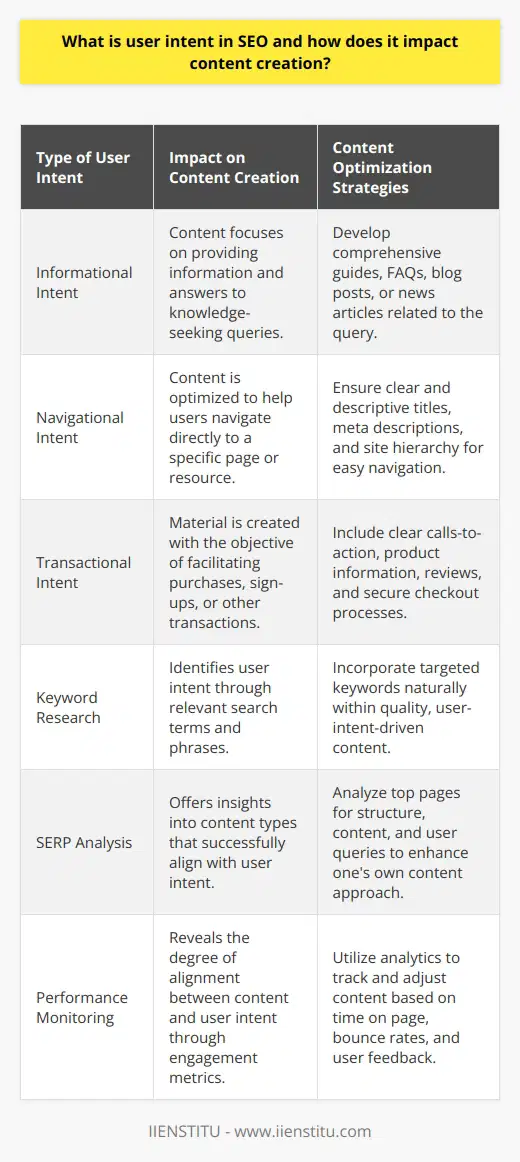
How can understanding search intent improve the effectiveness of keyword optimization?
**Search Intent and Keyword Optimization**
Understanding search intent is crucial in improving the effectiveness of keyword optimization for the following reasons: enhancing content relevance, increasing website traffic, and improving user experience.
**Enhancing Content Relevance**
By comprehending the intent behind search queries, content creators can tailor their blog posts to address the specific needs and expectations of the targeted audience. This alignment between search intent and content leads to higher relevancy, enabling search engines to rank and prioritize web pages accordingly.
**Increasing Website Traffic**
When the content of a blog post closely matches the search intent of users, it is more likely to appear on the first page of search engine results. This higher visibility results in an increase in web traffic, as users typically click on links that appear on the first page.
**Improving User Experience**
Finally, understanding search intent and incorporating it into keyword optimization ensures a better user experience. As users find the content they were looking for, they are more likely to engage with the website and its offerings, encouraging a positive perception of the brand and increasing the likelihood of repeat visits.
In conclusion, accounting for search intent in keyword optimization leads to increased content relevance, higher website traffic, and an improved user experience, all of which contribute to the overall success of a blog post.
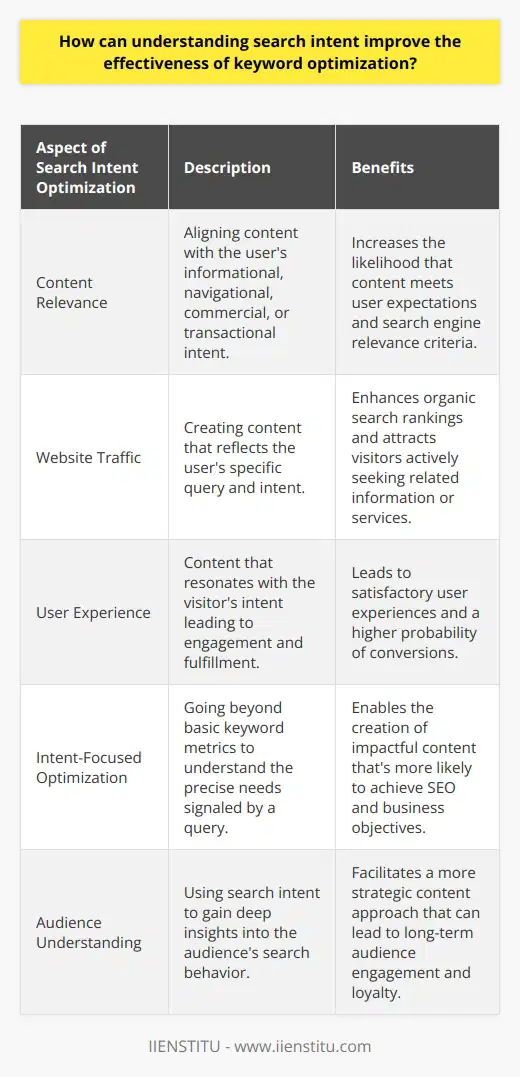
What are some best practices for optimizing content based on search intent to achieve better SEO results?
Understanding User Intent
To effectively optimize content for better SEO results, it is crucial to focus on user intent. By understanding the underlying motivations of a search query, marketers can better align their content to meet user needs and improve search engine rankings.
Fulfilling Search Intent through Valuable Content
One best practice involves creating valuable and informative content that addresses specific needs. By addressing search intent directly and answering relevant questions, content creators can enhance user satisfaction, leading to higher click-through rates and increased dwell time.
Keyword Research for Search Intent
Conducting thorough keyword research helps target content based on search intent. Identifying long-tail keywords and phrases that users search for and incorporating them into the content strategically enhances the content's visibility and relevance on search engine results pages.
Tracking and Measuring Success
Implementing analytics tools such as Google Analytics is a crucial step in tracking the success of content optimization. Analyzing key metrics such as organic traffic, click-through rates, and bounce rates can provide insights into the effectiveness of content optimization efforts, allowing for continuous improvement.
Adapting Content to Different Search Intent Types
It is important to differentiate between informational, navigational, transactional, and commercial investigation search intents. By tailoring content to fit each type of search intent, marketers can ensure that they cater to diverse user needs and enhance search engine visibility.
Mobile Optimization for Improved User Experience
With increasing mobile search volumes, optimizing content for mobile devices is essential. Ensuring that content renders appropriately on different screen sizes and platforms can improve user experience and positively impact search engine rankings.
In conclusion, focusing on search intent is integral to optimizing content for better SEO performance. By understanding user intent, creating valuable content, conducting keyword research, tracking success metrics, and adapting content to different search intent types, marketers can improve search engine rankings and increase organic traffic to their blog posts.
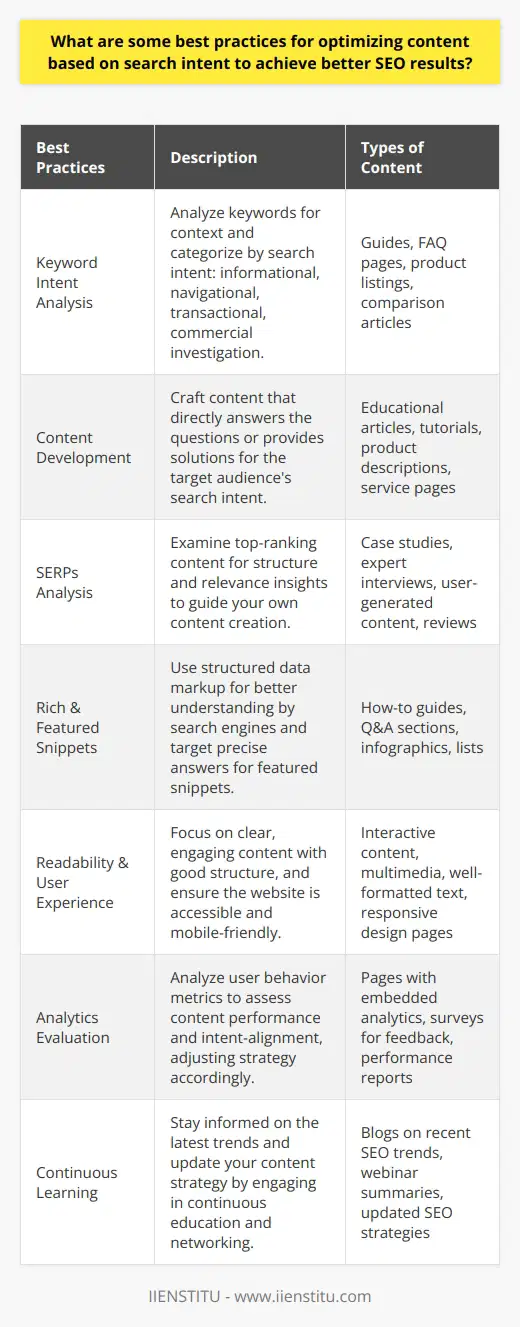
What is user intent in SEO and how can it be effectively analyzed?
Understanding User Intent in SEO
User intent in Search Engine Optimization (SEO) refers to the underlying motivation or goal that drives users to type specific search queries into search engines. By analyzing user intent, businesses can optimize their websites to address the needs of potential customers and enhance user experiences.
Methods of Analyzing User Intent
To effectively analyze user intent for SEO purposes, several techniques can be employed, including the analysis of search query types, monitoring search trends, and examining competitor strategies.
Analyzing Search Query Types
Search query types can be classified into different categories based on the purpose behind the searches. They can be broadly classified as informational, navigational, and transactional searches. Assessing the distribution of these categories can help identify the intents of users and allow businesses to adjust their content strategies accordingly.
Monitoring Search Trends
Keeping an eye on search trends, such as popular keywords, phrases, and search volumes, can reveal valuable insights into user behavior. By considering seasonal trends, geographical differences, and demographic factors, businesses can better understand user demands and preferences, and subsequently adapt their website offerings to cater to these needs.
Examining Competitor Strategies
Studying the SEO strategies utilized by competitors can highlight their successful methods of addressing user intent. By analyzing the site structure, content, and backlink profile of competing websites, businesses can gain insights into the topics and formats that resonate with their target audience and build these learnings into their SEO plan.
Leveraging Web Analytics
Using web analytics tools, such as Google Analytics, can assist businesses in evaluating user intent. By analyzing metrics like bounce rate, session duration, and conversion rate, companies can gain a clearer understanding of visitor behavior and identify ways to improve the user experience and, in turn, their SEO performance.
In conclusion, understanding and addressing user intent is a crucial aspect of SEO strategy. By employing analytical techniques, businesses can adapt their online presence to meet user needs, offering a more engaging and satisfying experience for visitors. This, in turn, leads to better rankings, increased traffic, and ultimately, business growth.
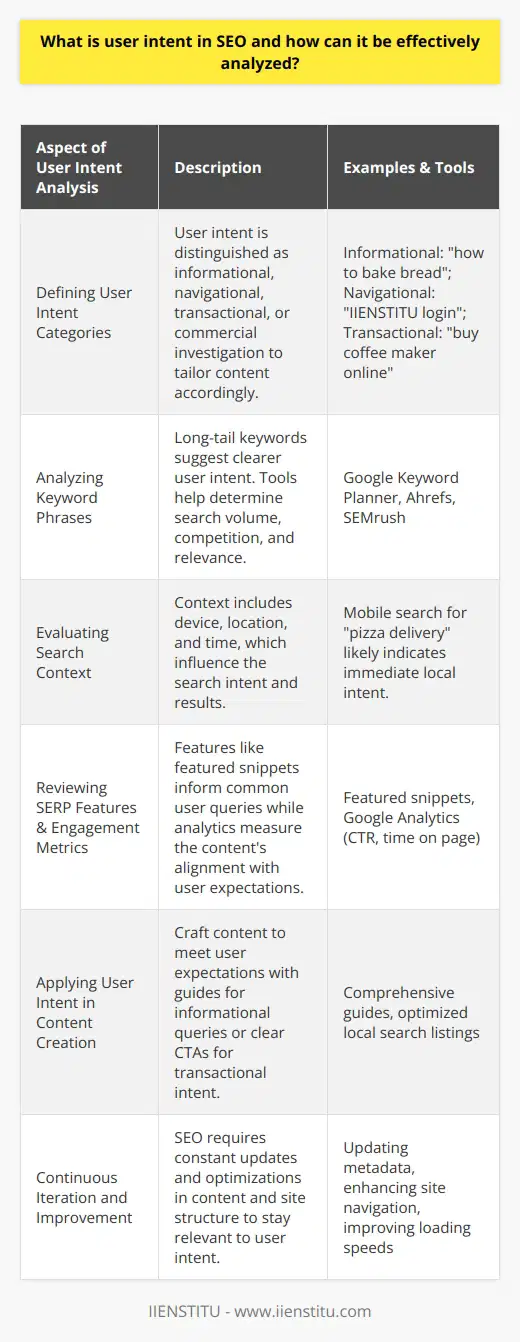
How can search intent influence the creation of targeted and valuable content?
Understanding Search Intent
Search intent, also known as user intent, refers to the ultimate goal a user has when typing a query into a search engine. Recognizing the search intent can indeed influence the creation of targeted and valuable content, which is essential for the success of a blog post.
Fulfilling Readers' Needs
Acknowledging search intent allows the content creator to address the specific needs of the audience. When content is in line with the search intent, it will most likely satisfy the user by providing the required information. This satisfaction then results in lower bounce rates and increased engagement in the blog post.
Tailoring Content Format
Moreover, search intent plays a significant role in determining the most appropriate format and structure of the content. For instance, in some cases, bulleted or numbered lists can be more effective than lengthy paragraphs. Analyzing users' goals allows content creators to present the content in the most consumable way, making it more appealing and tailored to the needs of the readers.
Keyword Optimization
Search intent also influences keyword optimization within content. Understanding the intent behind popular search queries helps content creators develop more accurate and relevant blog posts. By embedding pertinent keywords throughout the content, the blog post is perceived as valuable to both users and search engines alike, leading to improved organic search rankings.
Attracting Target Audience
Targeted and valuable content facilitates attracting the right type of audience to the blog. When the content resonates with the users' search intent, they will be more inclined to read the content, share it, and return to the site for further information in the future.
Enhancing User Experience
Finally, the user experience is significantly impacted by how well a content creator can comprehend and meet search intent. Providing useful, precise, and authentic information based on the intent will contribute to a positive user experience, which, in turn, can enhance the blog's authority and reputation.
In conclusion, understanding search intent is crucial in creating targeted and valuable content for blog posts. It guides content creators in crafting content that addresses the users' needs, maintains an optimal format and structure, effectively utilizes keywords, attracts the relevant audience, and improves the overall user experience. This critical information should not be overlooked in the process of developing blog content for a successful and engaging online presence.
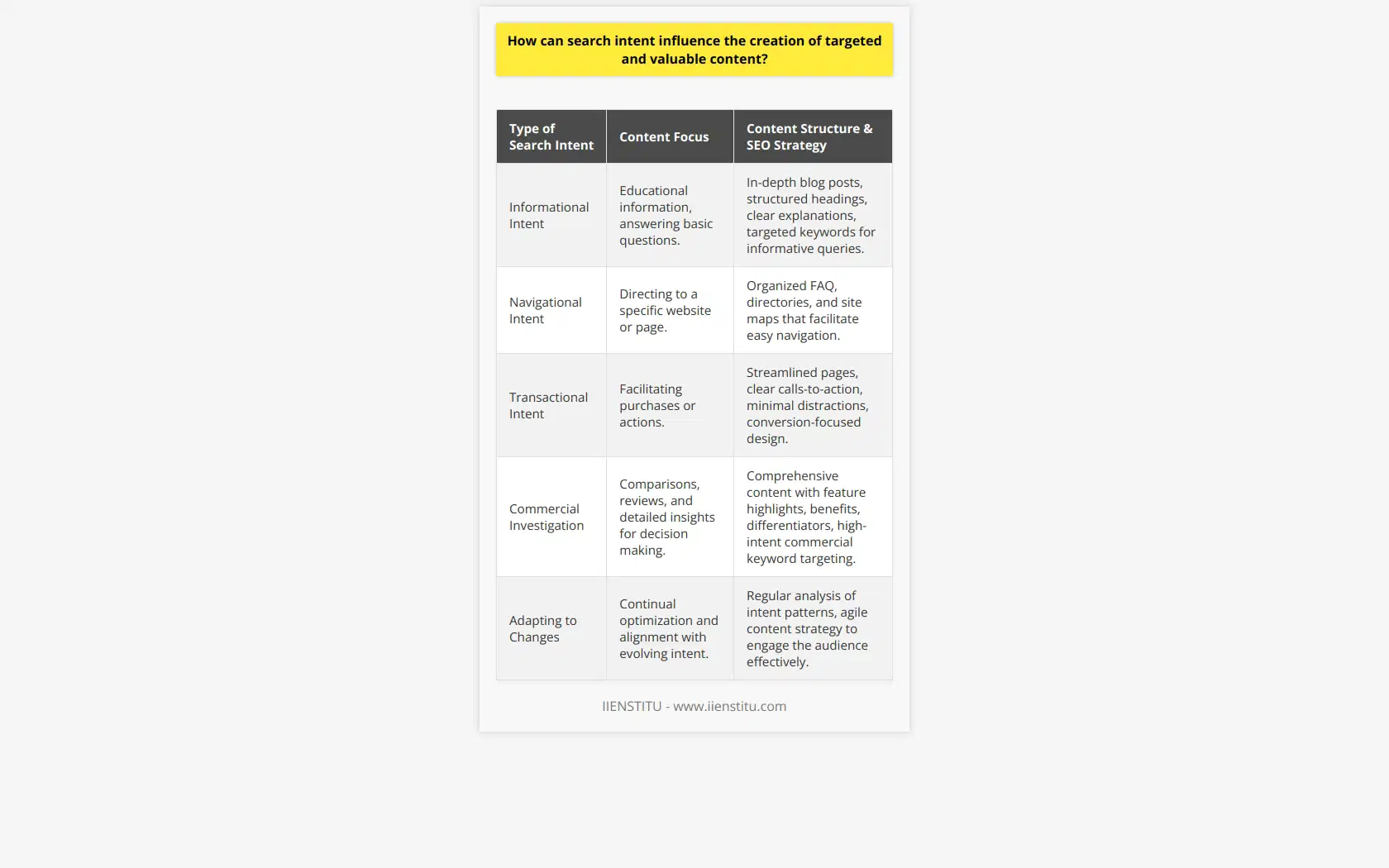
In what ways can the identification and application of search intent drive website traffic and improve search engine ranking?
Understanding Search Intent
The identification and application of search intent can significantly drive website traffic and improve search engine ranking in various ways. By understanding the underlying reasons prompting users to conduct a particular search, marketers can optimize their content to cater to those specific needs. This not only enhances user satisfaction but also boosts the website's visibility on search engine results pages (SERPs).
Tailoring Content to User Needs
When content is tailored to suit the search intent of users, it becomes more likely to satisfy their needs, prompting them to spend more time on the website. Longer user sessions signal to search engines that the website effectively addresses user needs, leading to improved rankings on SERPs. Consequently, these higher rankings attract more organic traffic, thereby increasing the website's potential audience.
Optimizing Website Elements
By optimizing various website elements based on search intent, such as headings, meta descriptions, and URLs, website owners can better align their content with users' expectations. This alignment can increase click-through rates (CTRs) on SERPs, as users are more likely to click on a result that seems to match their intent. Higher CTRs are also positively correlated with higher search engine rankings, further enhancing website visibility and traffic.
Targeting High-Value Keywords
Using search intent analysis enables website owners to target high-value keywords relevant to their audience, making their content more likely to be discovered by users. By focusing on these high-value keywords and crafting content that aligns with user intent, website owners can establish their authority in a particular niche. Over time, search engines begin to recognize this authority and reward the website with higher rankings on relevant SERPs.
Relevance and Quality Signals
Lastly, by addressing search intent in the content creation process, website owners are better equipped to produce content that is both relevant and of high quality. Search engines, especially Google, strongly emphasize both relevance and quality in their ranking algorithms. As a result, content that adequately reflects search intent is more likely to be rewarded with increased visibility and traffic.
In conclusion, identifying and applying search intent in content creation can significantly drive website traffic and improve search engine ranking. This process is achieved through understanding user needs, tailoring content accordingly, optimizing website elements, targeting high-value keywords, and ensuring content relevance and quality. Such efforts can lead to increased website visibility and, consequently, higher traffic levels.
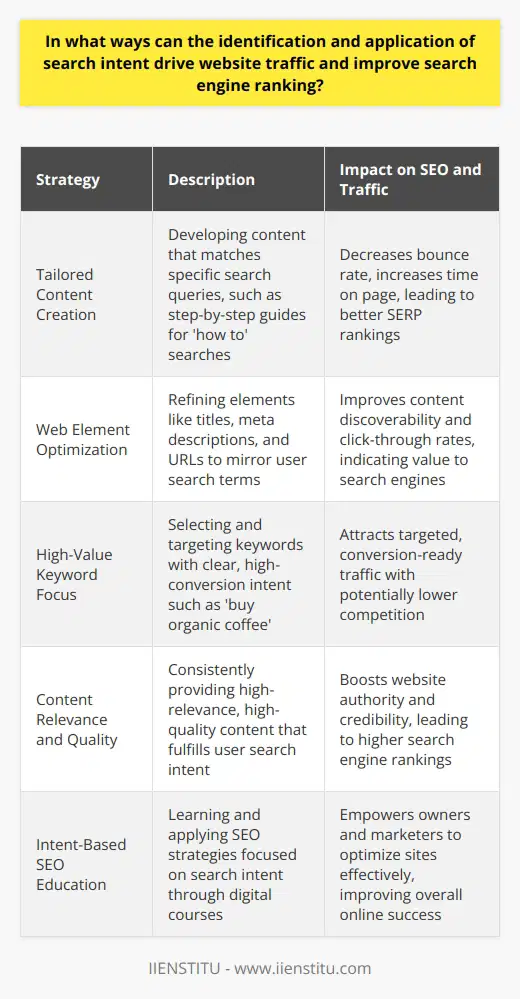
What is the role of search intent in the development of an effective SEO strategy?
Understanding Search Intent
Search intent, also referred to as user intent, plays a critical role in developing an effective Search Engine Optimization (SEO) strategy. It is the underlying goal a user has when typing a query into a search engine. Effectively, it reflects the users' expectations in receiving information, services, or products that align with their requirements.
Importance of Aligning with User Intent
Incorporating search intent into an SEO strategy can help improve a website's ranking on search engine results pages (SERPs), increasing its visibility and driving organic traffic. By providing content that matches the user's expectations, website owners can enhance user satisfaction, potentially resulting in decreased bounce rates, longer session durations, and increased engagement. Search engines, like Google, reward websites that cater to users' search intent by ranking them higher in the SERPs.
Identifying Different Types of Search Intent
There are four main types of search intent: informational, navigational, transactional, and commercial investigation. To create a successful SEO strategy, it is essential to identify the predominant intent behind users' search queries to optimize the website accordingly. Informational intent reflects the user's desire to gain knowledge on a subject. Navigational intent involves searching for a specific website or resource, while transactional intent represents the intention to buy or use a service. Commercial investigation refers to users researching products or services before making a purchase.
Strategies for Catering to Search Intent
To prioritize search intent in an SEO strategy, it is vital to conduct keyword research and analyze search query patterns to determine the users' goals. Website owners should create and optimize content that reflects their target audience's search intent, such as blog posts, buying guides, and product pages. Additionally, keeping the website's architecture user-friendly and easy to navigate can further enhance the user experience, resulting in better SERP rankings.
In conclusion, understanding and addressing search intent is essential for developing an effective SEO strategy. By aligning the content and website structure with users' expectations, website owners can achieve higher search engine rankings, increased organic traffic, and improved user satisfaction.
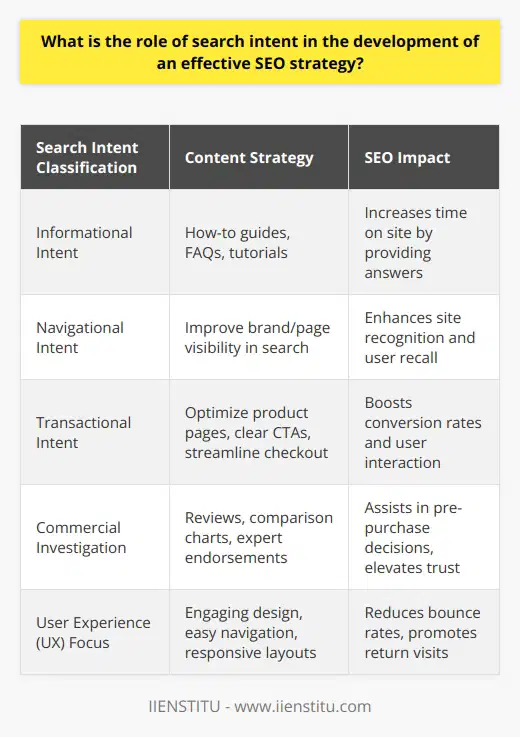
How can marketers accurately determine the search intent behind specific keywords and phrases?
**Understanding Search Intent**
To accurately determine the search intent behind specific keywords and phrases, marketers can apply various techniques. Primarily, they should analyze common search queries and the overall context.
**Examining Search Queries**
The first step is to examine popular search terms in the target niche. This can be achieved by using keyword research tools, such as Google's Keyword Planner, SEMrush, or Ahrefs. By identifying the most searched keywords, marketers can gain insights into users' preferences and behavior.
**Identifying Intent Categories**
The key is to classify the identified keywords into intent categories: informational, navigational, transactional, and commercial investigation. Informational queries are those where users seek knowledge, navigational queries involve searching for a specific website or page, transactional queries aim at buying products or services, and commercial investigation signifies research before making a purchase.
**Assessing SERP Analysis**
Search engine results pages (SERPs) can provide essential clues about the search intent. Marketers should observe the top-ranking results for a particular keyword, looking for patterns in the content type, format, and topics. For instance, if most top results are listicles, it might indicate the users' preference for easily digestible information on the subject.
**Using AI-Powered Tools**
Another approach to discern search intent is by utilizing AI-powered tools that rely on machine learning algorithms. These tools analyze search terms, SERPs, and user behavior to determine the most relevant content and format.
**Studying User Experience Metrics**
Analyzing user experience metrics, such as bounce rate, time on page, and click-through rate, can also shed light on search intent. These metrics reveal user satisfaction with the content and whether it fulfills their needs, helping marketers to create content that aligns with search intent.
**Incorporating Empathy and Human Perspective**
Lastly, marketers should consider empathy and a human perspective when determining search intent. By visualizing the user's situation and needs, they can develop a better understanding of intent and user expectations.
In conclusion, understanding search intent is crucial for marketers to create tailored and relevant content, thus generating better outcomes for their campaigns. By combining multiple techniques like keyword research, intent categories, and AI-powered tools, marketers can accurately determine search intent and refine their content strategy accordingly.
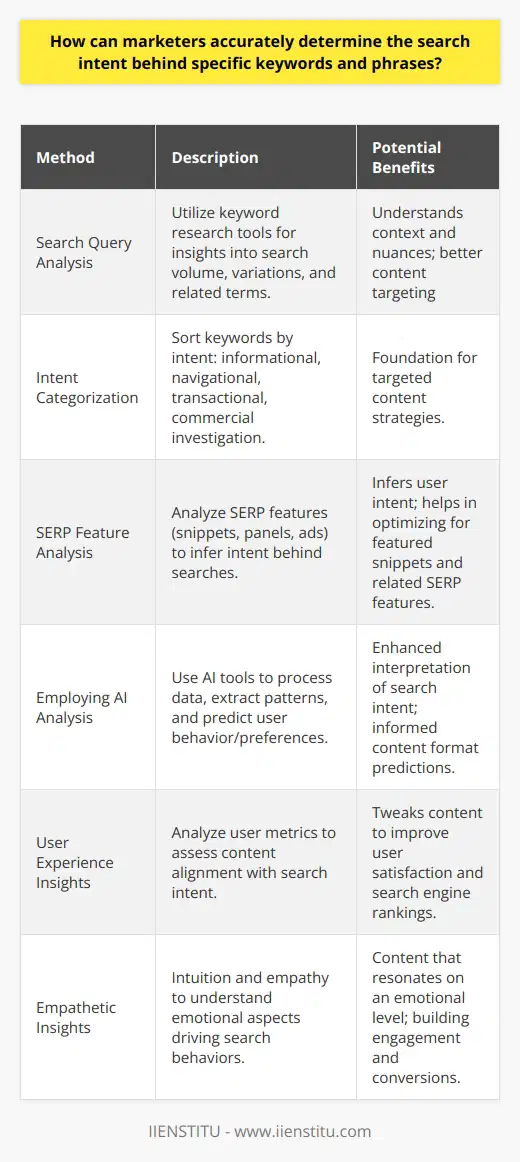
What are some techniques for aligning content with different types of search intent to enhance SEO performance?
Understanding Search Intent
To effectively align content with different types of search intent and enhance SEO performance, the first step is to understand the four primary categories of search intent: informational, navigational, transactional, and commercial investigation.
Keyword Research and Analysis
Keyword research is crucial in determining the terms and phrases that users typically utilize to search for content related to a specific topic. By analyzing these keywords, content creators can tailor their articles to target different search intent categories effectively. It is essential to use both long-tail and short-tail keywords to maximize the chances of reaching various users.
Content Creation and Optimization
Creating high-quality, original content that is both informative and relevant to the targeted audience is integral to fulfilling different search intents. For informational intent, long-form content with in-depth analysis, statistics, and expert opinions can be highly valuable. Navigational intent can be addressed by optimizing content structure through clear headings, bullet points, and easy-to-follow formatting. For transactional and commercial investigation intents, crafting engaging product descriptions, ratings, and reviews alongside persuasive calls-to-action is key.
Internal and External Linking
To further improve content alignment with search intent, internal linking within a website or blog assists users in navigating between related pages, allowing them to locate additional information with ease. Conversely, external linking to credible sources and authoritative websites helps to establish trustworthiness and enhance the organic reach of the content. These linking strategies aid in providing users with the desired search outcomes, ultimately improving a site's SEO performance.
User Experience and Mobile Optimization
Lastly, user experience and mobile optimization are crucial components of aligning content with search intent. Ensuring a fast-loading, responsive, and visually appealing site design is vital for users searching across various devices. Moreover, incorporating user-friendly features, such as chatbots and intuitive navigation menus, facilitate a streamlined browsing experience. As a result, these factors contribute to higher user satisfaction and increased chances of fulfilling their search intent, thus enhancing SEO performance.
In summary, aligning content with search intent to boost SEO performance requires a comprehensive understanding of search intent categories, diligent keyword research, well-crafted content, strategic internal and external linking, and an emphasis on user experience and mobile optimization. Implementing these techniques allows for effective content creation, ultimately resulting in improved search visibility, increased organic traffic, and better overall SEO performance.
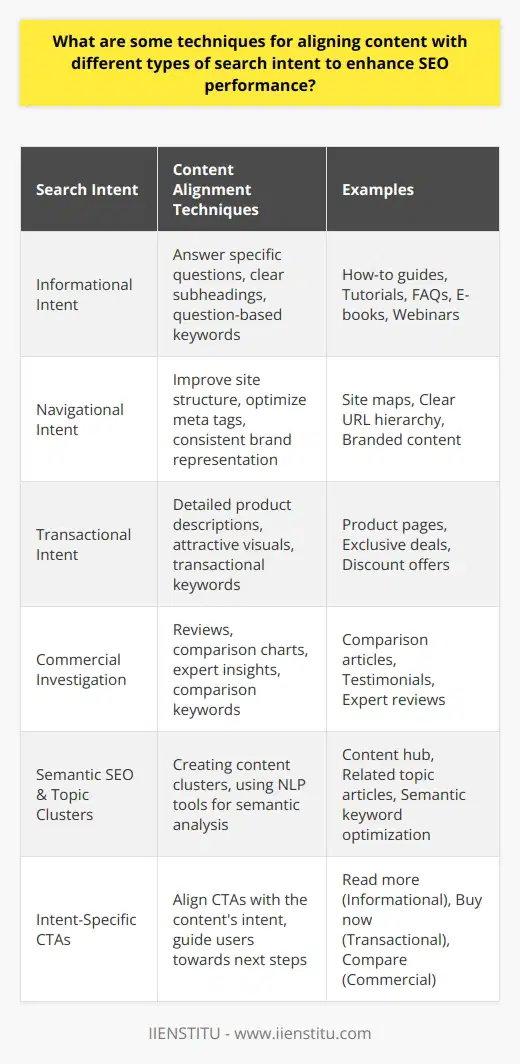
What is the difference between SEO and local SEO?
Understanding SEO and Local SEO
To understand the difference between Search Engine Optimization (SEO) and Local SEO, first we need to grasp the concept of each term individually.
Concept of SEO
SEO refers to a set of strategies that enhance a website's visibility in search engine results. It aims to increase organic traffic by improving the overall ranking on platforms like Google. SEO health depends on factors such as quality content, relevant keyword incorporation, and effective links.
Definition of Local SEO
On the other hand, Local SEO, as the name implies, focuses on optimizing websites for local search queries. Local businesses primarily use this to target potential customers in their geographical location. It relies on strategies such as local listing optimization and reviews management to improve search visibility in a specific area.
Differences between SEO and Local SEO
The primary difference between SEO and Local SEO lies in their goals and strategies. SEO targets the global market and works on improving the website's overall ranking. It is not confined to any geographical limits. Conversely, Local SEO targets a local market, optimizing the website for geo-specific searches.
The strategies for both also differ. For instance, SEO emphasizes keywords and backlinking, while Local SEO places more importance on local listings and reviews.
In sum, while SEO and Local SEO may seem similar, they cater to different markets and require different strategies for success. A business needs to choose between them depending on their target audience and their geographical concentration.
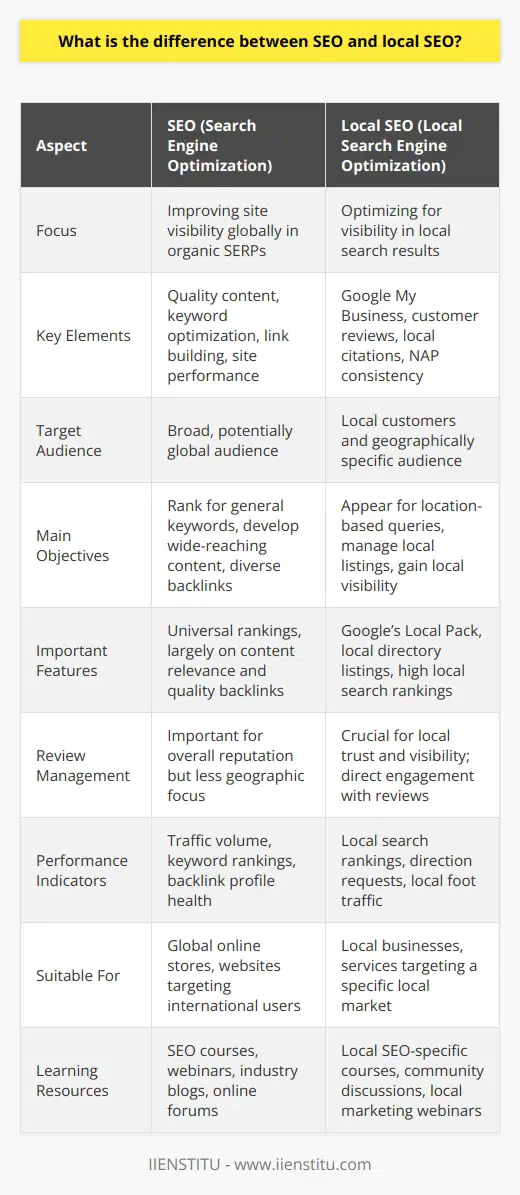
What is local SEO and why do we need local SEO?
Understanding Local SEO
Local SEO refers to the practice of optimizing a website to increase its visibility in local search results. These results can be from Google, Bing, Yelp, Apple Maps, and more. The primary goal here is to gain greater visibility in search results when users look for local businesses or services.
Importance of Local SEO
In today's digital era, many consumers rely heavily on search engines to find local information. Whether searching for the nearest restaurant, a nearby service provider, or a specific store's location, users turn to search engines. This is where the role of local SEO becomes critical.
Economic Implications of Local SEO
Adopting local SEO strategies helps businesses increase their online visibility, target potential customers, drive traffic to their website, and ultimately boost their profit. Local SEO strategies help businesses maintain a competitive edge in their local market, which is crucial for their survival.
Practical Benefits of Local SEO
Local SEO targets geographically relevant traffic, which results in a higher conversion rate. It allows businesses to specifically target potential customers who are in the vicinity, thus improving the chances of sales. Additionally, Google and other search engines prioritize local results, providing further incentive for businesses to optimize their local SEO.
In conclusion, local SEO forms a critical part of online marketing strategies for businesses of all sizes. It not only boosts online visibility but also helps increase customer base and profits. In today's progressively digital world, ignoring local SEO could lead to a significant loss in potential revenue and market share.
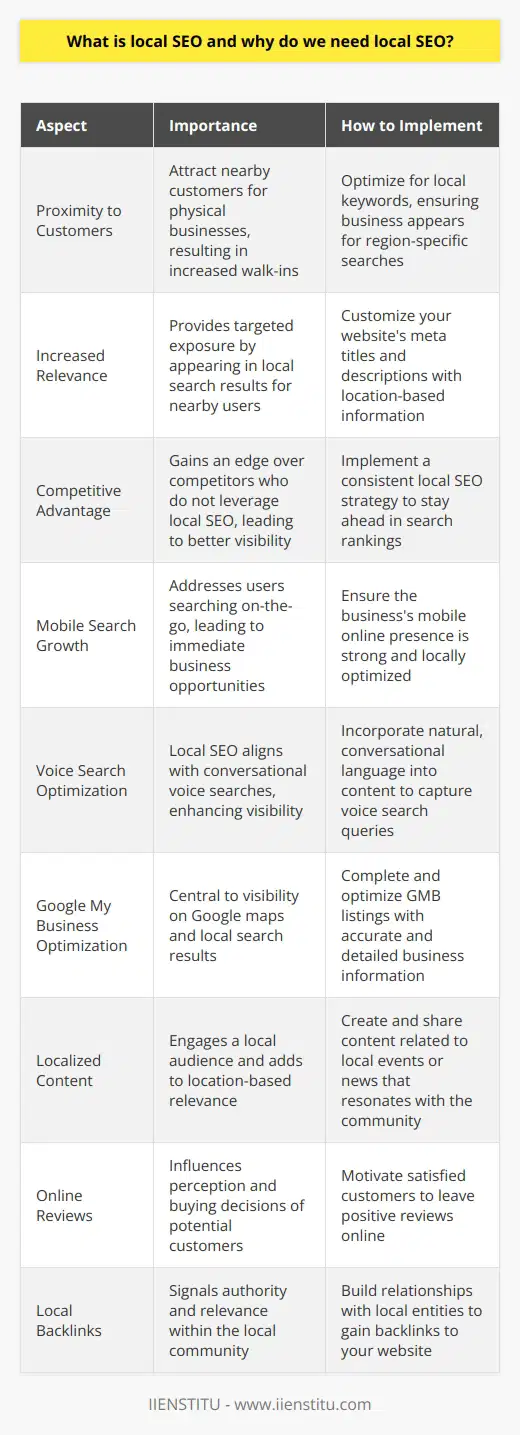
What is an SEO vertical?
Understanding SEO Verticals
An SEO vertical refers to a specific area within the search engine optimization field. Each vertical represents a unique aspect of SEO industry that commonly boasts its own set of techniques, strategies, and best practices.
Types of SEO Verticals
There are numerous SEO verticals including but not limited to local SEO, mobile SEO, video SEO and image SEO. Local SEO involves optimizing your online presence to attract more business from relevant local searches. Mobile SEO, on the other hand, means optimizing websites for an optimal viewing and interaction experience on mobile devices.
Individual Importance of SEO Verticals
Each vertical plays a critical role in a comprehensive SEO strategy. For instance, with the increasing usage of smartphones, mobile SEO can dramatically improve user experience and site usability, thereby contributing to better search rankings. On the other hand, image SEO can increase website visibility on image search results, driving additional traffic to the site.
Synergies among SEO Verticals
Despite their individual importance, these SEO verticals do not exist in isolation. They work together in synergy. For instance, effective local SEO might require a combination of traditional on-page SEO techniques with a mobile-friendly website.
Monitoring SEO Verticals
Irrespective of the specific SEO vertical, regular monitoring and updating are necessary to stay abreast of the constant changes in search engine algorithms.
In conclusion, understanding and effectively strategizing across the various SEO verticals can significantly boost a website's visibility on search engine result pages, making it an essential element in digital marketing efforts.


